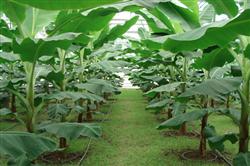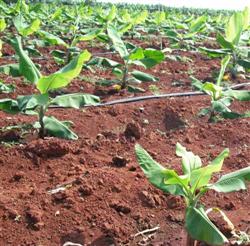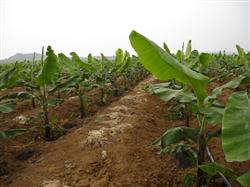How to fertilize bananas scientifically?

How to fertilize bananas scientifically? Please give a detailed introduction to the fertilization of bananas according to the growth stage of bananas. The following detailed analysis is for reference: (1) the growth and nutritional characteristics of bananas have no main roots, and the roots are most distributed in the range of 10-25 cm in topsoil. Sucking buds begin to sprout after February every year, so we should always do a good job in selecting and removing buds. Seedling stage: it takes 2-3 months to sprout and germinate until the big leaves are drawn out, and the plant growth in the second stage is small. Vegetative growth period: from the beginning of the extraction of large leaves to before the flower bud, it takes about 5-6 months, which is the vegetative growth period of bananas. the biological yield of plants in the secondary stage accounts for 30% of the biological yield of the whole breeding period. According to the investigation, the tall banana buds when 31-34 leaves are drawn, and the dwarf banana leaves 28-30 leaves. Fruit ripening period: male and female pollen is completed until the fruit is mature. According to the research, banana nutrition has the following characteristics: (1) Banana is a typical potassium-loving crop, and its potassium requirement is higher than that of any other country. (2) the nutrient absorption ratio of nitrogen, phosphorus and potassium in different banana varieties was about the same during the whole growth period, with an average of 1.19% and 3.72%. (3) the nutrient requirement of nitrogen, phosphorus and potassium of banana is not only related to the yield but also to the plant type of banana. For example, for every 1000 kg banana produced, medium-culm varieties absorb 5.9kg N, 1.1kg P (P2O5) and 22kg K (K2O). The dwarf banana absorbs 4.8kg N, 1.0kg P2O5 and 18kg K. (4) the demand of banana for calcium and magnesium was also very high, the absorption ratio of nitrogen to calcium was 0.69, and the absorption ratio of nitrogen to magnesium was 0.69, and the absorption ratio of nitrogen to magnesium was 0.2, which was higher than that of nitrogen and phosphorus. (5) the absorption of banana at each growth stage; the first growth stage was bud stage (accounting for 0.5%, 45.5%, 52.6%, respectively) > fruit development and maturity stage (40.2%, 37.2%, 31.0%, respectively) > vegetative growth period (19.3%, 17.8%, 16.4%, respectively). The second is the mature period of state affairs (accounting for 42.0%, 43.0% and 37.0% of the whole province respectively) > the bud stage (decibels accounting for 31.9%, 32.1% and 30.9% of the total growth period, respectively) > the vegetative growth period (26.1%, 24.3% and 27.1%, respectively). (6) the absorption ratio of nitrogen, phosphorus and potassium in different growth stages of banana is about the same, and the N:P2O5:K2O is about 3.5-4.5. This characteristic of banana fertilizer absorption makes it easier to grasp the proportion of nutrients in banana fertilization, that is, the same formula of fertilizer can be applied during the whole growth period of banana. (2) fertilization technology bananas generally need to apply 30-50 kg of nitrogen fertilizer per mu and 70-90 kg for high-yield bananas. The application ratio of nitrogen, phosphorus and potassium was 1. 3. 0. 3 and 0. 6. 1-2. There are differences in different soil conditions in different areas. For example, bananas in Guangdong need 70 kilograms of nitrogen (N) per mu in the whole year, and N:P2O5:K2O is 0.3 per mu, while bananas in Hainan need 90 kilograms of nitrogen per mu, and N:P2O5:K2O is 0.6 per mu. All localities can control flexibly according to the yield requirements and the status of soil nutrients. Banana needs to be fertilized many times in its annual growth cycle, about 10-15 times in the whole year. Organic fertilizer is generally applied in winter and spring, which can be applied in ditches and holes with a depth of about 20-30 cm from the head of the banana. Chemical fertilizer is generally suitable for topdressing during the growing period. Apply sparingly before budding. The cumulative amount of fertilizer application accounted for 75% of the total, and the newly planted sucking bud seedlings were fertilized twice a month from survival to before the extraction of 10 large leaves, each time accounting for about 3% of the total amount of fertilizer applied. The newly planted tissue culture seedlings were irrigated with 0.2% compound fertilizer solution every 7 days after the banana survived, for a total of 4-6 days, with the extraction of 10 large leaves, fertilizing once every 15 days, each time accounted for 3% of the total amount of fertilizer applied. During the period when the banana withdrew 10-16 large leaves, the plant growth accelerated and fertilized twice a month, each time accounted for 10% of the total. During the 16-23 large leaves of the banana, the plant increased significantly, the false base thickened, and the flower buds began to differentiate. Fertilizer should be paid attention to, twice a month. The amount of fertilizer applied each time accounts for about 15% of the total. With the re-budding stage is once, the amount of fertilizer application accounts for 15% of the total, in the early fruit stage is once, the amount of fertilizer application accounts for 10% of the total fertilizer. Generally, the acid soil in southern China is easy to lack magnesium, and 25-30 kg of magnesium sulfate or potassium magnesium sulfate is applied per mu. When the soil is boron deficient, 0.2% borax solution is sprayed 2-3 times in the early stage of banana growth period, and the effect of increasing yield is significant. Click to get more banana planting techniques click to get more fruit planting techniques
- Prev

How to apply fertilizer to grow bananas?
How to apply fertilizer to grow bananas? Please give guidance that banana is a fast-growing large crop and requires a large amount of fertilizer. the main principles for applying fertilizer should be as follows: (1) applying sufficient base fertilizer and several key topdressing; (2) combining organic fertilizer with chemical fertilizer; (3) promoting vegetative growth mainly with nitrogen fertilizer in the early stage and promoting vegetative growth in the later stage.
- Next

Introduction: the amount of fertilizer needed for banana
The amount of fertilizer applied to banana is closely related to soil fertility, climate characteristics, fertilizer properties, fertilization methods, varieties, growth period and planting density. A good harvest can be achieved with fertile soil and less fertilizer. For example, banana plantations in some mountainous areas of Hainan Island have a yield of 30kg per plant without fertilization. Heavy rainfall, high dry, high products.
Related
- Moge, come on! The staff of the peasant association in the producing area of cantaloupe were frightened when the crowd gathered.
- Causes and Solutions of low Fruit setting rate of Apple
- Symptoms and control measures of passion fruit virus disease
- Fruit growing lesson: how do apple orchards keep high yields?
- Can you build orchards in the mountains? What are the pros and cons?
- How to manage the coloring period of Crisson grape?
- This paper introduces the processing technology of two kinds of fig products.
- How much is a month for retired teachers in rural areas by 2020?
- How can strawberry planting increase sugar content? We should pay attention to management in many aspects.
- What are the cultivation techniques on how to improve the yield of golden fruit?

